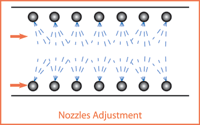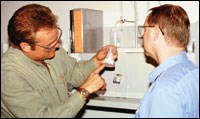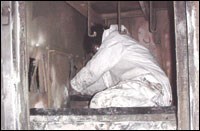The Real Cost of Not Maintaining Your Paint Pretreatment Washer
What is the real cost of not maintaining your paint pretreatment washer system? More than you probably realize…
Companies must prepare metal surfaces prior to painting in order to provide good paint adhesion and corrosion resistance to their finished product. If this job is not done properly, the service life of the painted finish is severely affected. The metal spray washer system is an integral component in providing a quality finish, and it requires periodic attention to ensure that daily performance is up to standards, keeping maintenance costs at normal levels.
In this article, we will provide you with an easy to follow preventive maintenance plan designed to save time and effort, while keeping your paint pretreatment wash system at peak performance. Along the way, we will provide proof of the costs associated with a poorly maintained pretreatment washer to sufficiently justify any maintenance expenses to the Finance Department.
Achieving continuous operation of your spray wash system is dependent upon being diligent in the removal of contaminants. Contaminants come in many forms, from tramp oils, iron sludge, lost parts, water hardness, excess chemicals and everyday dirt. In fact, maintaining chemical concentrations, smooth conveyor operation, control equipment and all facets of the washer will be critical in gaining peak performance.
Sludge will be generated in both the cleaning stage and the pretreatment stage. Some sludge is actually beneficial in the pretreatment stage as it provides additional iron. Sludge, however, should never get to the level where it comes in contact with fire tubes or heating plates. In the cleaning stage, the same rule applies where all the sludge is considered waste and is not beneficial. Certain chemicals and metals generate more sludge than others do.
Sludge levels can be easily checked via a plastic tube or even by a stick. It is best checked after the washer has not been run for at least a shift; typically this is overnight. Simply immerse the tube into the bath until it reaches the bottom, then place the palm of your hand or a plug over the top end and raise the tube out of the bath. You will be able to see how much sludge has accumulated by looking at the bottom of the tube without removing your hand or the plug. Next place the bottom of the tube back over the bath and remove your hand and the fluid will flow back into the tank. Rubber gloves should be worn when performing this task. If the tank temperature is above 110F, care must be taken not to burn or scald your hand. This is when the stick method may be better, though the stick will not permit a visual on the sludge amount like the tube.
To use the stick method, just select a stick long enough to reach the bottom of the bath and immerse. Once bottom contact is made, slowly move the stick in a circular motion to feel the sludge. The more sludge, the harder it will be to move the stick. Some interpretation on the part of the person checking will be needed to determine sludge levels. Sludge will wreak havoc on heat transfer, coating quality, cleaning ability, nozzles, screen cleaning, and scaling of the entire washer. It is important to monitor the sludge levels in your washer to keep it operating at peak performance.
Water hardness is the invisible menace, as it causes poor chemical activity and reduces the performance of both alkaline and acidic products. Typical water hardness components, calcium and magnesium, are the two major culprits in the formation of scale deposits. When these ions are combined, in solution with pretreatment chemicals, they often react to form inorganic, insoluble compounds. These compounds deposit or precipitate on the tank walls, headers, risers and heat transfer surfaces.
In a paint pretreatment spray washer, the formation of calcium and magnesium orthophosphates is common. These compounds are soluble at lower temperatures and become insoluble at the higher temperatures found at and near heat transfer surfaces. When phosphating, inorganic, insoluble, iron or iron/zinc phosphate WILL be present in tank solutions; deposits on heating surfaces and in equipment plumbing are inevitable.
Water hardness will also grab onto other particulates present in the washer such as soils and help them plate out as well. In combination with iron sludge, water hardness will expedite the development of scale on heating surfaces, which will reduce heat transfer rates and increase energy costs. By paying attention to water quality and using RO water, or other treated water, your washer maintenance will be greatly reduced.
Scale deposits, regardless of their origin, act as an insulating blanket that reduces the rate at which heat is transferred from the hot side of a heat exchanger to the cold side or pretreatment chemical solution. Quantifying the exact resistance that scale contributes to decreasing heat transfer efficiency requires experimentation due to the infinite possible compositions of the insulating material or scale.
Our experience has shown that if we assume an even distribution of an insulating scale, the effects can be approximated by the following:
|
Thickness of Scale (Inches)
|
% Loss of Efficiency
|
|
1/32
|
4
|
|
1/8
|
18
|
|
1/4
|
28
|
The cost of heating is such that even the smallest decrease in heat transfer efficiency can escalate costs significantly. A single, 1,000 gallon spray wash stage operating at 130F, 350 days per year, 16 hours per day, with 1/8 inch of scale on its heating surfaces can cost an additional $9,000 per year in extra fuel. Although fuel prices are regional, this dollar figure assumes a fuel cost of $5.00 per mm Btu. For steam heated systems, the additional cost is incurred at the boiler where additional fuel is needed to generate the heat for the fire tubes. These costs represent only a single stage; paint pretreatment is typically done in three to seven stage systems, so additional costs add up significantly.
As we have seen, the cost of scale affects not only maintenance but energy as well. In the long run it also affects the cost of capital. Scale left unattended will trap moisture and expedite corrosion, which shortens equipnment life. Planned checks and maintenance is the cure for the cost of scale.
The breakdown of maintenance on paint pretreatment wash systems is divided into daily checks, weekly/bi-weekly checks, monthly checks and semi-annual checks. The two key elements here are time and “checks.” Most preventive maintenance programs fail because of a lack of organization and commitment. To effectively begin organization, we need a schedule (time) and a “to do list” (checks). It is important to remember that breaking down preventive maintenance into small “digestible” chunks is easier and more cost effective than waiting for a nuisance failure, or worse, catastrophic failure to dictate when maintenance is performed. Production costs, energy costs and potential loss of business are all expenditures that can be directly attributed to poor maintenance schedules, organization and implementation.
Daily checks are extremely important because common sense tells us that by keeping in daily contact with a system we will be more aware of potential problems and/or actual problems in the process. Most problems in paint pretreatment wash systems can be spotted and even corrected during periodic daily checks. Daily checks should not be taken lightly; they should be done thoroughly as they can affect the efficiency of your system and reduce the maintenance dollars spent over the course of a year. They are key in preventing costly, untimely, shutdowns during peak production periods and help ensure you meet production levels for customer satisfaction.
DAILY CHECKS:
Daily Checks that should be performed to ensure the overall performance of your spray wash system:
1. Check screens (each shift). The primary duty of the screens in your washer is to protect your pumps from foreign matter such as shop towels, parts that have fallen into the washer and everyday debris. Pumps are costly and to repair them may require washer shutdown if your washer is not equipped with a secondary/standby in case the primary pump fails. Screens also help prevent debris from fouling headers, risers, and nozzles, which can drastically affect the quality of the work as well as increase the potential for costly, untimely downtime.
There should be two screens (constructed of stainless steel mesh of 1/8-inch size) placed in front of the pumps. Two screens allow cleaning to be performed one screen at a time, which prevents foreign materials from passing into the pump during cleaning. It is important for those performing this check to be aware that they should not remove both screens at once. Usually all that is needed to clean screens daily is fresh water and a brush. When screens are checked every shift and cleaned properly, problems are eliminated at the source.
2. Check for any fallen work and obstructions in the headers, risers and nozzles at least once per day. Clear obstructions as soon as possible to prevent additional obstruction created from buildup of solids in blocked area.
“Outlaw” parts that fall into the chemical baths and rinses can cause problems. In the chemical stages, the chemical is constantly acting upon the metal and this contributes to sludge and excess chemical usage. In the rinse stages, as the metal rusts or corrodes the dissolved metal becomes a soil and/or an environmental issue if galvanized metal is processed. It should be easy enough to understand that if some of this “stuff” gets pulled into a pump or header, problems can escalate fast!
3. Overflow each stage to flush away surface contaminants. In a perfect world we would turn over all tanks at least once per shift. In reality, environmental and cost concerns will not permit this practice. Today, it is possible in most plants to overflow rinses and wash stages at a reasonable rate, but it is dependent upon local wastewater regulations or plant wastewater treatment capability.
One way to overflow rinses is to counterflow rinse waters back into the previous chemical tank. In a five-stage process, counterflowing uses the rinse waters (typically stages No. 2 and No. 4) that have a similar pH to replenish the water loss from the cleaning (typically stage No. 1) or phosphating (typically stage No. 3) operation, which brings fresh water into the rinses and insures the rinse water is kept as clean as possible. The contaminants rinsed off in the rinses consist of chemical and associated soils, which can be added to the previous stage as makeup. Care must be given however to ensure that rinse waters from stage No. 4, which will have acid contaminants, are not counterflowed to stage No. 1, which are typically alkaline. Your chemical supplier can help you immensely with this process.
4. Turn on conveyor. Watch and listen for signs of trouble. Jerky operation and large buildup of soil and/or chemical on the conveyor are both disasters waiting to happen. Jerky operation usually means a fouled roller or poor lubrication. This can lead to a complete failure through breakage, and it can cause parts to fall into the chemical baths and rinses.
Another suggestion on conveyor operation is to minimize stopping and starting the conveyor during production. Maintaining continuous conveyor operation prevents over treatment of parts and rusting of parts in process. This is not truly a maintenance issue but can contribute to poor production quality and results.
5. Check chemical concentrations and pH at the beginning and end of each shift. Maintaining the recommended use concentration and pH ensures the results you were assured from your chemical supplier when you chose their service.
Excessive concentrations wastes chemical can cause maintenance issues by contributing to sludging and residue buildup on washer surfaces. Too lean of concentration causes poor part quality and leads to corrosion of the washer and associated equipment.
6. Turn on the ventilation fans and check for smooth operation. Afterwards, with the fans OFF, examine for chemical buildup in the stack.
7. Check heater operation. This should be concurrent with monitoring operating temperatures. Too high of temperatures will cause rapid formation of residues, scaling, rusty parts and poor quality production. Too low of temperatures will cause poor part quality. Maintaining proper temperatures goes hand in hand with proper concentration control and pH control. This is essential for maintaining quality production parts.
8. Check for missing nozzles. Nozzles are occasionally knocked off by poorly hung parts. This should be checked daily and repaired immediately. Most washers use snap on nozzles, which can be replaced very quickly. Not doing so will reduce the riser pressure due to the lost nozzle and contribute to streaked and poor quality production parts.
9. Turn on the pumps and listen for growling bearings or other irregular operation. Follow the manufacturer’s recommended maintenance instructions.
10. Walk the system at least once daily checking all the above. Care should also be given to check control equipment. Occasionally temperatures should be checked with a thermometer against what the controller states. Concentrations and pH should also be tested by titration and litmus paper or meter and compared to controllers.
WEEKLY/BI-WEEKLY CHECKS:
These Weekly/Bi-Weekly Checks are easy to perform:
1. Remove end caps on risers and flush out solids. Remove all caps or open ball valves if end caps have been replaced by ball valves, turn on pumps and flush the solids from the pipe. If you do this faithfully every week or every other week, plugged nozzles and plumbing will be greatly minimized. Remember to replace end caps or close ball valves before resuming production. This practice requires someone to enter the washer, so make sure safety and lockout procedures are followed.
2. Check for clogged nozzles. This can be easily done when someone enters the washer to remove the end caps or open ball valves. The easiest way to check is to direct the light of a high beam flashlight into the nozzle. Any clogs will be very apparent.
The proper cleaning procedure for clearing obstructed nozzles is to remove the nozzle during the plumbing flush. The nozzle(s) can then be chemically cleaned and replaced when the end caps/ball valves are replaced/closed. Alternatively, you can have extra, clean nozzles available to replace any that are fouled. Sometimes it is a good practice to leave the nozzle out as you flush the plumbing. This provides another opening for debris to exit. If more than one nozzle is clogged in a riser you may want to give extra scrutiny to that area to determine the cause. Do not try to “poke out” the obstruction by probing with a wire or pick with the nozzle in-place. This will only dislodge the soil to refoul the same, or another, nozzle. Incidentally, this can bore out the openings causing poor spray patterns.
Clogged nozzles adversely affect good diamond shaped spray patterns. Not having a good spray pattern will lead to poor cleaning, streaked parts and poor quality paint finish. If neglected too long, clogged nozzles will lead to riser fouling, which will clog even more nozzles and lead to expensive washer downtime and unscheduled maintenance.
Worn and/or damaged nozzles should also be replaced during this check.
Nozzle checks, when done regularly, do not require much time. An experienced wash line operator can complete an end cap/ball valve flush with nozzle check in less than one hour. If neglected and he/she has to replace numerous nozzles, etc., the time and expense go up.
3. Check nozzle alignment. Nozzle alignment is extremely important to ensure a diamond shaped spray pattern and to minimize overspray contaminating subsequent stages. Proper nozzle alignment is typically 12 inches apart and staggered from riser to riser (see diagram on page 57). A five to ten degree slant is appropriate as well to ensure proper coverage of the part. Spraying Systems Co.Ò has a book titled, “Spray Nozzle Maintenance Handbook,” which covers nozzle care in its entirety. (For more information on this book, Spraying Systems Co., 630-665-5201, fax: 630-665-0319, www.spray.com)
At the very least these checks should be conducted once every month. Weekly or bi-monthly checks are preferable.
SEMI-ANNUAL AND/OR ANNUAL CHECKS:
Generally speaking, a spraywash paint pretreatment system needs to be dumped and descaled once per year. In some cases due to work load, soil load and water conditions this may be increased to twice per year. Most companies can get by with one time per year provided they have done their daily, weekly and monthly checks.
You should consult with your pretreatment chemical supplier for assistance with descaling. They can help with chemicals, safety tips and procedures.
In this article we have given you preventive maintenance suggestions that are proven to work. The key is to DO them; as they say, “no pain, no gain.”
DuBois Chemicals, Surface Finishing
Read Next
Delivering Increased Benefits to Greenhouse Films
Baystar's Borstar technology is helping customers deliver better, more reliable production methods to greenhouse agriculture.
Read MoreA ‘Clean’ Agenda Offers Unique Presentations in Chicago
The 2024 Parts Cleaning Conference, co-located with the International Manufacturing Technology Show, includes presentations by several speakers who are new to the conference and topics that have not been covered in past editions of this event.
Read MoreEducation Bringing Cleaning to Machining
Debuting new speakers and cleaning technology content during this half-day workshop co-located with IMTS 2024.
Read More




















.jpg;maxWidth=300;quality=90)




